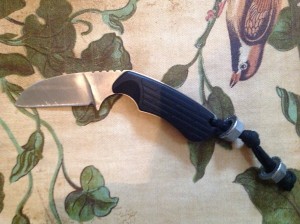Fighting the Powell Doctrine by M.D.H.
Posted by admin on Jan 26th 2015

Some things are invented, most things are discovered. The tactics of a modern battlefield will always predate that battlefield; in the mind of the successful criminal rests somewhere between one and all of the dynamics of educated combatants. If one thing can be assumed, it is that anyone who believes they are dangerous to you, is dangerous to you and there must be a reason why.
There are many tactics and tools that one could assume the enemy has. So many in fact that a person could become bogged down trying to understand what is common and what is rare. Understanding certain overarching laws can save you that trouble and keep you in class and the gym; sharpening your skills instead of getting lost in rabbit holes.
In essence, the Powell Doctrine (named by General Powell) is an attitude that tactics and tools are filtered through. It is the philosophy of hitting as hard as you can, as early as you can. Surprise is its primary asset, like hearing the whip and only having that data to react to; in such a case, you are already struck. This piece wont be long, but I am hopeful that it will be long enough to show you how you can maybe see that whip and the man holding it long before its deployment. This will be a treatise on thinking, not action. For those who think they can survive without study, may this show you how wrong you are.
Trinity of Force-Numbers, Weapons and Power
Robbery, rape and murder are all confidence games. What I mean by this, is that without confidence these crimes would not occur. The violator must believe they are superior. This exists on a sliding scale but is universal. The highjacking’s that lead to 9/11 are an example of this: sure they’re only coming with box cutters, but you say “only” because you may have a shotgun in your closet or a four inch folder on your person. With only empty hands to offer, a box cutter is a severe life threat. If you aren’t aware of these factors, you will become your enemies “slam dunk” and life will never be the same.
Tackling the issues in order: it is a serious risk to engage one target by yourself. Should you find yourself against a lone combatant, I would advise being skeptical of your eyes; odds are good that wherever your weak point is, another combatant is waiting for you there. We don’t point rearward: the only thing that can fire backward with any effect are the elbows and still, it will not be a fight ender if you cant face and engage that threat immediately after.
A solution to this that doesn’t involve hyper awareness or installing eyes in the back of your head is to exit behind your opponent. If someone is in fact attempting to box you in, you must neutralize them and circle toward their back. Not only is your safest exit behind them, so is the safest point to engage from. It is also an opportunity to use your first opponent as a human shield if the need arises.
Weapons are an issue so serious that martial artists who consider themselves competent will seek knowledge and training in these tools, knowing that at some point the enemies hand enhancer–whatever it may be–could enhance them well beyond the skills of any unarmed combatant. Ive heard odd numbers now and again: the idea that comes to mind first is that a martialist of a year takes on the ability of one of five or more years just by picking up a knife. Attaching any number is silly, but the point is hard to miss: hand enhancers increase lethality. All the man needs is luck after that and you will drift into the past tense.
Taking on weapons is always ill advised if you came to the party empty handed, but you must do what is easiest even if it is terrifying. When confronted with fight or flight conditions, you must be able to discern which option is safest and easiest. Assuming you engage, there is little I can impart to you from here, save to remind you to cover your head and neck first and engage viciously. Leave your opponent on the ground and unable to follow as you flee the scene.
Concerning how you engage as an armed citizen: remember that it isn’t your job to match his weapon, but to exceed it. Fair fights are butchery. You may be incredibly well versed with your stick or knife, but all they have to do is want victory more. You may think to yourself, “how could a man want my wallet more than I want to live?” My only answer is that poverty is a lifestyle. You will only be under attack for a billionth of the time that a person can live paycheck to paycheck or suffer crippling anxiety wondering where the resources for life will come from. This may be the person standing in front of you. Don’t assume anything except that they will do anything and do it like they mean it.
Finally, we come to power: part illusion, part reality. Muscle and size aren’t a power per say, but they are a layer that will interfere with power transfer in striking as well as your ability to kick effectively or defend. When someone like that has the mount on you, the only thing thats going to get you home is a weapon or a friend. When someone thinks they can kill you single handed: don’t challenge them on it. Keep your weapons and friends close because no man can kill many unarmed and none can fight effectively with half a magazine worth of bullets in them.
Protecting the S.O.I.-Drawing a Line in the Sand
In the case of combat, we need space to live. Actually we don’t, we need space to think. We need time to respond effectively to what appears and that can only be done with space. If you reach your hand out, you are touching the limits of your Sphere of Influence. This is the place someone has to be to negate all of your skill and ability. You can stop one thing at that distance, but only something you’ve stopped a million times before; something you’ve trained for.
Thinking you can prevail at this range is half a fallacy: only half because it may well be true; it becomes a full-fledged fallacy if you actually put yourself in that position. The space you want is several miles, the space you may have to settle for is one full step away from your S.O.I. this is traditionally thought of as the minimum measurement of the Line in the Sand.
It’s just enough time for the brain to say “incoming” and for the body to respond effectively. The Tooler Drill paints an even graver picture: showing that a person can close from twenty feet before a pistol can be produced and actuated. You train to be comfortable up close, but don’t ever think that means you should be.
Know the Ground-Tricks, Traps and Exits
In many ways, the ground is as great a factor in a fight as the person you face. When you fall, it never misses. When ignored, it takes on the intention of whoever is paying attention to it and can use it. A fire hydrant is stronger than any sidekick, a bench is a takedown that cannot be countered and a wall is the one way to punch someone everywhere all at once.
Gentle grades in a sidewalk will disrupt balance: its not often that a fighter will lift their feet to move forward and even less common while moving backward. Carl Cestari was an advocate of only stomping to move: the moving Jong of Wing Chun was something I initially distrusted on account of that. The truth of the matter is that you must fight two battles; one with a human, the other with the ground. Both must be watched and both demand different approaches.
As for exits, there are two kinds; exits in known areas and exits in unknown areas. In a place you know you have choices: you can weigh them out in a split second and be through the door immediately. In a place you don’t know there is only one safe exit; once the engagement has begun and you can no longer look around, it is only behind your opponent.
Properly Equipped-The Law, Friends and Planning
Everything done well requires forethought. If I really don’t feel well about a thing, ill bring a friend or two; preferably someone who’s already been where I’m about to go. It changes your unknowns into knowns all in a sudden. In this way, humans can be even more valuable than weapons though their presence doesn’t invalidate them. The ability to avoid a fight–to practice discernment–is by far the best way to carry.
I live in Pennsylvania, but I work in New Jersey. Initially, this threw my system of carry into chaos. Suddenly, most of my knives were no good and my gun was out of the question: in a few years they may be as restrictive as a jumbo jet. Eventually, I stumbled across an HK Plan D. Shaped like a Kabar TDI, but with a thinner, more useful profile. I carry it tucked into my wallet on my strong side. It can be drawn just like my gun and the angle is nearly identical. Its location on my body also allows me to skip a step in production: I no longer have to clear my cover garment as the pocket itself serves to conceal the weapon.
In this instance, I’ve managed to carry without changing anything jerastically and I’m still in harmony with the police agencies I pass through en route to and from work. Ive had to sacrifice, but I still run efficiently. There are situations where I’ll pay a little more to avoid “unfree” areas, but when it cannot be avoided, I will adjust. Thinking flexibly, being proactive and staying optimistic are sometimes your only assets; never leave them at home.

